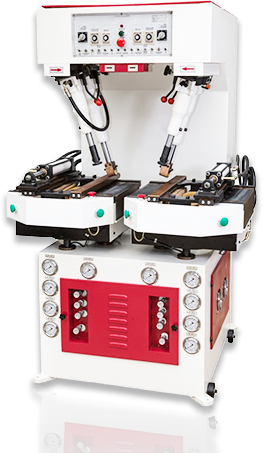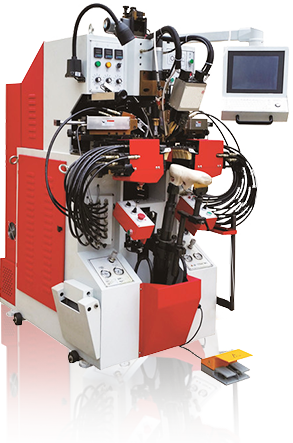The shoe machine industry is one of the industries most closely related to the shoe industry. Not only is it influenced by the development of the majority of shoe companies, it also restricts the development of shoe companies to a great extent. After so many years, the Chinese shoe industry has experienced a difficult development process from scratch, from few to many, mainly from imports to the rise of domestic shoe machines.
1. From 1978 to 1988, China's shoe machine was in its infancy
my country's shoe-making machinery industry was born in the 1980s. In the first 10 years of reform and opening up, China's footwear industry is basically a process of modernization driven by foreign footwear processing such as Hong Kong and Macao. The original traditional footwear production areas, such as Shanghai, Beijing, Guangzhou, Wuhan, Chengdu, Chongqing The equipment used by state-owned shoe companies such as Qingdao and Qingdao is basically the equipment of domestic shoe machine factories, and the types of shoe machines are relatively simple. Commonly used shoe-making machines include simple manual bottoming machines, mechanical cutting machines, small ovens, and sewing machines. Shoe-making machinery imported from abroad is relatively rare. The Wenzhou shoe machine industry in the early 1980s gradually developed due to the strong market demand.
2. From 1989 to 1998, China's shoe machine ushered in a development period
With the continuous reform and improvement of the market economy, the living conditions of Chinese residents have also greatly improved, and the requirements for shoes have gradually increased. In response to the requirements for improving the quality of shoes, a large number of private shoe-making enterprises have emerged throughout the country. The establishment of a private shoe factory has greatly driven the demand for shoe-making machinery. As a result, many shoe-making enterprises have emerged one after another. At present, most of the backbone enterprises of Chinese shoe machines were born in this period.
At the same time, a large number of Taiwanese-funded footwear manufacturing companies flooded into China during this period, which drove the Taiwanese footwear industry to set up strongholds in China. However, because the market economy conditions in early China were not perfect in many respects, some Taiwanese-funded systems were established in mainland China. Shoe companies are not satisfied with the situation. Taiwan-owned shoe-making factories unfortunately closed down, and a large number of second-hand shoe machines flowed to private shoe factories in China, which greatly improved the modernization of Chinese shoe-making technology. Among them, Fujian, Quanzhou, Jinjiang, and Wenzhou, Zhejiang, have received unprecedented opportunities for development because of the introduction of modern shoe-making lines.
3. From 1999 to 2008, China's shoe machine entered a period of growth
These 10 years can be called "the golden age of the Chinese shoe machine industry". During this period, the Chinese shoe industry seized the opportunity of export, coupled with the improvement of the quality and quantity of the domestic market, it obtained unprecedented opportunities for development. The entire Chinese shoe machine industry has also achieved unprecedented development. In the first three years of the early 21st century, my country's annual sales of shoe-making machinery increased at a rate of more than 20% every year. In 2002, although China suffered a SARS raid, it did not affect the equipment update of shoe factories. Industry sales exceeded 30%, and many companies increased their orders, which could not meet the needs of the market. Statistics obtained from the China Leather Association in the first half of 2008 showed that the export of leather and footwear machinery was 25,000 units, a year-on-year decrease of 4%, and the value of exported machinery was US$290 million, an increase of 7% year-on-year. Although the number of my country's shoe-making machinery exports has declined due to the financial crisis, the amount of exports has increased. These achievements were hard-won.
After more than 20 years of hard work, China's shoe-making machinery has produced more than 300 pioneer companies, mainly distributed in Fujian, Wenzhou, Guangdong, Jiangsu, Shandong and other places. Among them, the number of enterprises in Fujian, Zhejiang and Guangdong accounted for 90%, and sales also accounted for more than 90%. The shoe machine products currently produced by these enterprises can basically be produced from shoe design, upper manufacturing equipment, molding equipment to sole installation, whole shoe decoration and laboratory equipment, and the quality is stable.
5. After 2009
The prospect of the entire shoe machine market in China is still good. Product upgrading will be accelerated, and the product quality requirements will be high, especially in terms of energy saving and labor cost reduction. Therefore, many shoe machine companies are increasing investment to develop new products and improve product quality. In addition to these requirements, shoe manufacturers require lower prices and better service.
The Chinese shoe machine market is relatively optimistic in the future, because the manufacture of shoes is unlikely to leave China. However, with the development of the market, it will be concentrated, some will be eliminated, and some will be stronger, especially manufacturing companies. The market will be more fragmented and will not be concentrated in a few places, and the markets of other developing countries will become larger and larger.
From the technical level, the mainland shoe machine is almost the same as the Taiwan shoe machine (made by Taiwan brand mainland), and some products are completely indistinguishable. But European shoe machines have certain advantages in certain high-end products. Therefore, at present, European shoe machines still occupy the mainstream of high-end shoe machines, although this part accounts for a small share of the entire market. Taiwan's shoe machines are still quite competitive, because they are almost "continentalized", especially in Taiwanese-funded shoe factories in the mainland, their market share is still the majority, estimated at 60%. The space for the development of the shoe-making machinery industry is still very large. China has the largest market. The export industry has just started. There are also many needs for technology development and innovation. Enterprises should strengthen management, tap potentials, adapt to the development and changes of the situation, and continue to study. New technology and new technology, while learning Italian equipment technology, should also learn the scientific and standardized management of Italian enterprises, as soon as possible to shorten the gap with the Italian shoemaking machinery industry, as soon as possible to make China develop from a major shoemaking machinery powerhouse into a shoemaking machinery powerhouse.
6. The regional development of shoe-making enterprises in recent years has the following characteristics
In the territory of the global footwear industry, China is undoubtedly the most powerful army, because in the global annual production of 20 billion pairs of shoes, "Made in China" has more than 10 billion pairs. China's footwear industry is developing rapidly, and the total annual production of footwear products has accounted for 51% of world production.
Among them, for now, the Chinese shoe machine industry has basically formed the situation of Jinjiang, Guangdong, Wenzhou and Yancheng.
Jinjiang-the base camp of sports shoe machine
As the region with the largest production of sports shoes, travel shoes and casual shoes in China, Fujian Jinjiang currently has more than 3,000 shoe-making enterprises, with an annual output of nearly 500 million pairs of shoes. In recent years, the city has cumulatively introduced more than 2,000 shoe-making lines (sets), and invested an average of 800 million yuan in technological transformation annually, which is fertile ground for the development of shoe-making machinery.
Guangdong-raw material market boosts shoe machine industry
As a key shoemaking region in China, Guangdong is the raw material production place of leather products in countries and regions of the world, especially the main region of footwear products. Driven by this, a large number of shoe-making machinery enterprises have grown in Dongguan, Shenzhen and other regions.
Wenzhou-take the international route
Wenzhou, the shoe machine industry started late, but with the private capital of Wenzhou investing in the shoe industry in the 1990s, many shoe factories were built and expanded, requiring a large number of shoe machines and related services, so the development is extremely rapid.
Yancheng-"Hometown of Chinese Shoe Machines"
In Dagang Town, Yancheng City, Jiangsu Province, there are more than 100 shoe machine manufacturing enterprises and 15 scheduled enterprises. It has more than 1,200 sets of various production equipment such as planing, grinding, milling and boring. The leading products are shoe cutting, pressing, Compounding, cutting machinery, etc., can produce 100,000 sets of shoe-making machinery annually, more than 60% of enterprises have annual sales between 3 million and 8 million yuan, becoming the leading industry of the town's industrial economy, its total economic scale, financial and tax contribution share 3. The employed workers account for more than 1/3 of the town's industry. (Information comes from the network)







